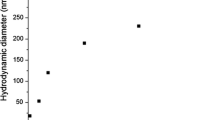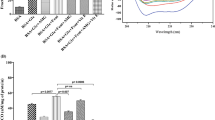Abstract
Nonenzymatic glycation of biomacromolecules occurs due to the diabetes mellitus and ageing. A number of small molecules, known as chemical chaperones, stabilize protein conformation against thermal and chemically induced denaturation. These compounds are including: polyamines (e.g. spermine and spermidine), amino acids (e.g. lysine) and polyols (e.g. glycerol). In this study the effect of spermidine (Spd), spermine (Spm), and glycerol on glycation, structure and function of lysozyme (LZ), as an extra-cellular protein, by different techniques is investigated. LZ is incubated with or without glucose (50 or 100 mM) in the absence or presence of Spd/Spm/glycerol at 37 °C up to 16 weeks. All the observed changes of glycated-LZ in comparison with the native protein, including: increased fluorescence emission, alteration in the secondary and tertiary structure, and reduced electrophoretic mobility- indicate its structural changes that are accompanied with its reduced activity. Glucose in the presence or absence of Spd induces the protein dimerization, but glucose plus Spm induces its trimmerization. In contrast, glycerol inhibits the LZ glycation and prevents the large changes on its structure and function. Glucose binds lysine residues, decreases the protein positive charges and induces some alterations in its structure and activity. Polyamines also directly bind to LZ, increase its positive charges and hence induce more glycation; more conformational changes, oligomerization and its inactivation in the presence of glucose, but glycerol affect the protein environment and preserve protein from these harmful effects.









Similar content being viewed by others
Abbreviations
- Glc:
-
Glucose
- LZ:
-
Lysozyme
- Spm:
-
Spermine
- Spd:
-
Spermidine
- AGE:
-
Advanced glycation endproducts
- CD:
-
Circular dichroism
- Asp:
-
Aspartate
- Glu:
-
Glutamate
- Arg:
-
l-Arginine
- Lys:
-
l-Lysine
- AG:
-
Aminoguanidine
References
Bachrach U, Wang YC, Tabib A (2001) News Physiol Sci 16:106–109
Bathaie SZ, Jafarnejad A, Ashouri MR, Mirmiranpour H, Shirali S, Nobakht F, Bahmani F, Alipour A, Nakhjavani M, Khaghani S (2011) IXth European Symposium of the Protein Society, Stockholm, Sweden
Bathaie SZ, Moosavi-Movahedi AA, Ranjbar B, Saboury AA (2003) Colloids Surf B Biointerfaces 28:17–25
Brownlee M, Vlassara H, cerami A (1987) In: Crabbe, MJC (Ed.) Diabetic complications, scientific and clinical aspects. Edinburgh: Churchill Livingstone Edinburg, pp 94–139
Coussons PJ, Jacoby J, McKay A, Kelly SM, Price NC, Hunt JV (1997) Free Rad Biol Med 22:1217–1227
Goldberg ME, Rudolph R, Jaenicke R (1991) Biochemistry 30:2790–2797
Gugliucci A, Menini T (2003) Life Sci 72:2603–2616
Gugliucci A (2004) Clin Chim Acta 344:23–35
Gupta S, Chough E, Daley J, Oates P, Tornheim K, Ruderman NB, Keaney JF (2002) Am J physiol Cell Physiol 282:560–566
Ha HC, Sirisoma NS, Kuppusamy P, Zweier JL, Woster PM, Casero RA (1998) Proc Natl Acad Sci USA 95:11140–11145
Igarashi K, Kashiwagi K (2000) Biochem Biophys Res Commun 271:559–564
Jafarnejad A, Bathaie SZ, Nakhjavani M, Hassan MZ, Banasadegh S (2008) Diab Metab Res Rev 24:64–73
Jafarnejad A, Bathaie SZ, Nakhjavani M, Hassan MZ (2008) Life Sci 82:301–307
Jafarnejad A, Bathaie SZ, Nakhjavani M, Hassan MZ (2008) J Pharmacol Exp Therapeut 324:850–857
Janne J, Alhonen L, Leinonen P (1991) Annal Med 23:241–259
Jenzano JW, Lundblad RL (1988) J Clin Microbiol 26:34–37
Jolles P, Jolles J (1984) Mol Cell Biochem 63:165–189
Kalousová M, Zima T, Tesar V, Lachmanová J (2002) Blood Pur 20:531–536
Khan AU, Mei YH, Wilson T (1992) Proc Natl Acad Sci USA 89:11426–11427
Kislinger T, Humeny A, Peich CC, Zhang X, Niwa T, Pischetsrieder M, Becker C-M (2003) J Agric Food Chem 51:51–57
Laemmli UK (1970) Nature 227:680–685
Li YM (1998) Adv Exp Med Biol 443:57–63
Li YM, Tan AX, Vlassara H (1995) Nat Med 1:1057–1061
Liggins J, Furth AJ (1997) Biochim Biophys Acta 1361:123–130
Liu H, Zheng F, Li Z, Uribarri J, Ren B, Hutter R, Tunstead JR, Badimon J, Striker GE, Vlassara H (2006) Am J Pathol 169:303–313
Lomozik L, Gasowska A, Bregier-Jarzebowska R, Jastrzab R (2005) Coord Chem Rev 249:2335–2350
Mason DY, Taylor CR (1975) J Clin Pathol 28:124–132
Masuda T, Ide N, Kitabatake N (2005) Chem Senses 30:253–264
Masuda T, Ide N, Kitabatake N (2005) Chem Senses 30:667–681
Méndez JD, Leal LI (2004) Biomed Pharmacother 58:598–604
Monnier VM (2003) Arch Biochem Biophys 419:1–15
Ono Y, Aoki S, Ohnishi K, Yasuda T, Kawano K, Tsukada Y (1998) Diabetes Res Clin Pract 41:131–137
Peeters T, Vantrappen G (1975) Gut 16:553–558
Powroznik B, Gharbi M, Dandrifosse G, Peulen O (2004) Biochimie 86:651–656
Rahmanpour R, Bathaie SZ (2011) J Biomol Struct Dyn 28:575–586
Reisfeld RA, Lewis UJ, Williams DE (1962) Nature 195:281–283
Stitt AW (2001) Brit J Ophthalmol 85:746–753
Takata K, Horiuchi S, Araki N, Shiga M, Saitoh M, Morino Y (1988) J Biol Chem 263:14819–14825
Zheng F, Cai W, Mitsuhashi T, Vlassara H (2001) Mol Med 7:737–747
Acknowledgments
This research was supported by Iranian National Science Foundation grant No. 88000429. The authors are also very thankful to the Research Council of Tarbiat Modares University for supporting this project.
Author information
Authors and Affiliations
Corresponding author
Rights and permissions
About this article
Cite this article
Bathaie, S.Z., Nobakht, B.B.F., Mirmiranpour, H. et al. Effect of Chemical Chaperones on Glucose-Induced Lysozyme Modifications. Protein J 30, 480–489 (2011). https://doi.org/10.1007/s10930-011-9353-x
Published:
Issue Date:
DOI: https://doi.org/10.1007/s10930-011-9353-x




